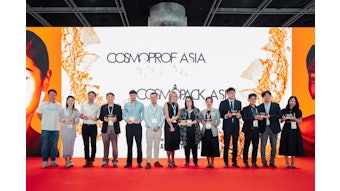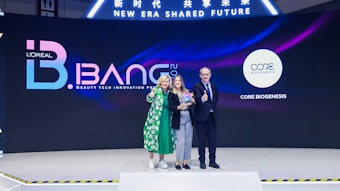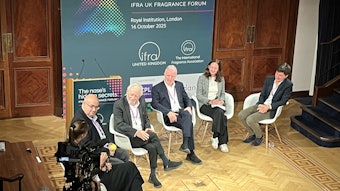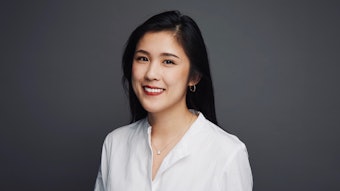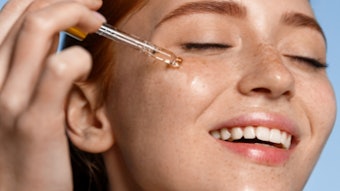"Beauty for a New Age," was the them for day one of IFSCC. Morning presentations took a deep dive into delivering product efficacy and insights on the skin microbiome, while the afternoon focused on skin health/protection and well aging, and advances in hair science. Notably, there was standing room only for talks focused on skin aging and luminescence. Following are select highlights.
See related: Skin Microbiome; A New 'Organ' and How to Leverage It
Delivering Product Efficacy: Skin Glow, Ingredient Efficacies, Age Spots, Dark Circles and More
Skin repair and lasting lip shine: Prof. Rachel Watson, of the University of Manchester, opened with a keynote exploring chronic photodamage and evidence for topical anti-aging cosmetics to remodel skin. Jinwoong Kim, of Sungkyunkwan University, presented on skin regeneration by Euglena gracilis algae-derived extracellular microvesicles created through extrusion. Also, Tsang-Min Huang, of L’Oréal R&I, demonstrated the creation of a one-step, lasting color/shine lip gloss using liquid-liquid phase separation.
Glow across ethnicities: Cyril Messaraa, of Oriflame, highlighted a study carried out to define skin glow using a "hybrid" product combining instant effect and slight coverage for longer term effects. "Glow is the great 'ambassador' of holistic beauty claims," he observed. His work uncovered global consumer insights and clinical testing interpretations, such as the need for duplicate measurements on a wider panel of ethnic skin and skin types. He also noted the importance of looking within and across ethnic skin groups for perceptions of skin glow. This means including multidimensional factors that make measurements for skin glow more relevant to consumers; for example, including pigmentation, which is important to Chinese consumers.
See archived: Industry Insight; Self-pleasuring Linked to Glowing Skin Benefits
Ingredient synergies: Christopher Berkey, of Stanford University, sought to exploit ingredient interactions to optimize the delivery and performance of skin care formulations. "In formulation, emollient penetration is enhanced and remains highly correlated with stress reduction in skin," he said. The higher the amount of emollient, the lower the stress and the greater the penetration. "Large emollients that poorly penetrate in their pure form have the greatest enhancement from formulation inclusion," he added. Furthermore, the firing rate of skin's mechanoreceptors play a role in perceived skin tautness or softness; the higher the firing rate, the tighter skin feels.
Emollient penetration is enhanced and remains highly correlated with stress reduction in skin.
During the Q&A session, one attendee asked whether this work explored these effects in different types of skin. Indeed, it had, and the percentage change in skin stress and penetration had strong agreement across different donor tissue types. Another audience member wondered how Berkey explains the higher efficacy for the larger molecules. "We think the other formulation ingredients, especially water, maintain hydration and swelling, which allows them to better penetrate," he said. "The efficacy is on par with smaller emollients."
Lipid-enhancer nanoparticles: Jun Bae Lee, of COSMAX, presented on skin lipid enhancer-incorporated lipid nanoparticles and their ability to interact with the stratum corneum to improve skin efficacy and barrier function. His work leveraged the late Johann W. Wiechers', Ph.D., work on formulating for efficacy and penetration.
E-cadherin breakthrough against age spots: Daigo Inoue, of Shiseido Co., presented a breakthrough in the fight against age spots: E-cadherin. His work demonstrated how the down-regulation of E-cadherin, which is a key factor in keratinocyte-keratinocyte and keratinocyte-melanocyte contacts, can serve as a target to address age spots via various pathways; including melanocyte dynamics themselves, the secretion of melanocyte/inflammatory factors, melanin uptake and melanogenesis, and differentiation/proliferation. "E-cadherin is an origin factor to the processes of melanin formation," he explained. One attendee remarked, following the presentation, "This is opening a new chapter in age spots."
Retinol alternative: Rounding out the delivery session, Valerie Bicard-Benhamou, of Merck KGaA, presented an alternative to retinol for anti-aging effects referred to as RCL (INCI: Sorbitol (and) Dihydroxy Methylchromone (DHMC or noreugenin)). This molecule is found in numerous plants and was first isolated from Nauclea orientalis. The in vivo work demonstrated promising results, including better efficacy with a 2% RCL o/w formulation than a 0.2% retinol commercial formulation; notably, the active in the RCL formula (0.1% DHMC) was present at half the concentration of the retinol. The ingredient specifically was shown to reduce matrix-degrading enzymes induced by aging/stress and to build up key components of the epidermis and extracellular matrix to reduce the signs of aging.
Dark circles reduction in 3D bioprinted model: Finally, Colin McGuckin, of CTIBiotech, successfully linked the efficacy of a product, Ipomea batatas root extract, shown to clinically reduce vascular dark circles, to an in vitro vascularized 3D bioprinted skin model. According to McGuckin, the future in this space is bioprinted hair for efficacy testing.
Skin Microbiome Front: Endolysins, Lantobiotics and Other Ideas
In her keynote address, "Harnessing Skin Microbiome Intelligence for Healthy-looking Skin, Magali Moreau, of L'Oréal Paris, explained that we know some things about how the microbiome interacts with skin, e.g., the tight junctions, but we know less in terms of how it interacts in cases like acne. One reason is that other entities including sebocytes, immune cells and keratinocytes participate in the formation of acne.
"We know the composition of the skin microbiome changes with age, showing reductions in Cutibacterium acnes. ... And that the diversity increases in an polluted environment," she explained, noting its similarity to aged skin.
Moreau also highlighted different approaches in today's "toolbox" that are taken to leverage the skin microbiome, ranging in complexity from prebiotics and postbiotics, to other bio-derived materials, phages and probiotics. She offered lantobiotics (proteins to change behavior) and endolysins (produced by phages) as potential new opportunities, especially considering their specificity. Moreau also believes that linking observations from omics with clinical effects will help to advance the industry's understanding from mere shifts in the microbiome, to changes in function and finally, to levers for performance. She envisions a true skin microbiome model of the future to bring solutions for healthy skin.
Additional presentations during the microbiome session included:
- Hye-Young Yoo, Kolmar Korea: a comparison of scalp microbiome according to the severity of androgenic alopecia and gender in a Korean cohort;
- Aïna Queiroz, Seqens Cosmetics, on new findings about the impact of exposome on skin microbiome;
- Paul Lawrence, Biocogent, on revolutionizing modern skin care with an old technology, phage therapy, in the Age of the Skin Microbiome;
- Nico Forrazo, CTIBiotech, on the "world’s first" human ex vivo acne sebaceous gland model colonized with virulent phylotype of C. acnes;
- Lionel Muniglia, Biolie, on the calorization of fruits and vegetables coproducts to produce natural organic active waters for cosmetic formulation;
- Sabrina Leotyokombi, BASF Beauty Care Solutions, on the first use of a droplet-based microfluidic method to highlight specificities of microbiote communities from sensitive skin;
- Patrick Gonry, Gobiotics, on the skin microbiota under stressful circumstances; and
- Richard Leroux, Sederma, on a new pentapeptide to improve skin surface damage on the face induced by C. acnes activity.
Skin Health, Protection and Well Aging: Ring Collagen, Capsaicin-free Red Pepper Extract and More
In his keynote address, "A New Horizon in Anti-aging Skin Care," Tomonobu Ezure, of Shiseido, presented a highly engaging video demonstrating how tension differs in skin, the causes of it, and its implications in skin sagging for a novel anti-aging approach. More specifically, he identified how fine hair fibers within the "voids" of skin collagen "rings" can remodel the surrounding rings by expanding the proteoglycan (PG) layer via Wnt16. This can support the regeneration of ring collagen in what Ezure describes as "environmental transplantation," for facial rejuvenation effects.
See archived: [video] Tomonobu Ezure, Ph.D., on Shiseido's 3D Skin Scanning Tech
Ring collagen is an emerging target for skin care [and] ... Wnt16 secreted by fine hair fibers can increase ring collagen.
"Ring collagen is an emerging target for skin care," Ezure concluded, adding that this is the skin's physical system to maintain skin morphology. (To view a clip from his presentation, see our LinkedIn page).
Additional presentations in the skin health, well aging and protection session included:
- Audrey Faure-Grousson, of Erborian (L’Occitane Group), on capsaicin-free red pepper extract for energized, radiant and non-irritated skin;
- Frédéric Flament, of L’Oreal R&I, on broader photoprotection to efficiently cover the whole UV spectrum, showing long term clinical anti-aging benefits in a real life split-face study;
- Torsten Fauth, of BRAIN Biotech, on improving the skin barrier by targeting the TRPV4 ion channel with bioactive compounds;
- Julie Leignadier, of IFF Lucas Meyer Cosmetics, on transforming visible light for skin care;
- Franck Bonnier, of LVMH Recherche, on line-field confocal optical coherence tomography coupled to artificial intelligence to identify quantitative biomarkers of facial skin aging;
- Tümerkan M. Kesim, of Eskişehir Technical University, on understanding the effects of particle size and anisotropy on microstructural and rheological properties of suspoemulsions; and Lauriane Roux-Imbert, of Greentech, on gentiopicroside-rich Gentiana lutea extract for the eye contour area.
Advances in Hair Science and Technology: Hair Testing, Carbonated Water and Other Insights
During sessions on hair science, Noriyuki Tanji, of Kao Corp., presented on enhancing the penetration of ingredients into hair fibers using carbonated water. p-Toluene sulfate (PTS) served as the model ingredient. "Carbonated water promotes the curl-loosening effect using PTS," he said, adding that washing hair using carbonated PTS shampoo significantly improved hair style by aligning curls without relying on surface-adhesive ingredients. More specifically, he explained that carbonated water "increases the macrofibril flexibility and facilitates the penetration of PTS into the macrofibrils."
During the Q&A session, attendees had questions as to whether the increased acidity in the carbonated water was creating this effect, or if it was the presence of that gas. Tanji was unsure.
Additional presentations featured during this session included:
- Jennifer Marsh, of Procter & Gamble, on using solid-state 1H NMR relaxation methods to quantify small molecule interactions and damage in hair;
- Yasunori Okuma, Arimino Co., on the simultaneous 3D visualization of hair microstructure and damage using FIB-SEM;
- Cindy Delvallé, of Dow, on the effects of cationic/hydrophobic-modified hydroxyethyl cellulose polymers on heat-styling damage;
- Prof. Franz-Josef Wortmann, of the University of Manchester, who gave a keynote on hair testing opportunities and challenges;
- Brittany Pease, of Inolex, on enhancing the conditioning performance of cationic amino lipids by formulating for optimized lamellar gel networks; and
- Sylvie Marull-Tufeu, of Yves Rocher, on visualization and quantification of an active ingredient in hair fibers using coconut oil as an example.
After the day closed out, attendees enjoyed the evening's social gathering at Madame Tussauds wax museum. Follow us as we continue coverage on Day Two of the congress.
